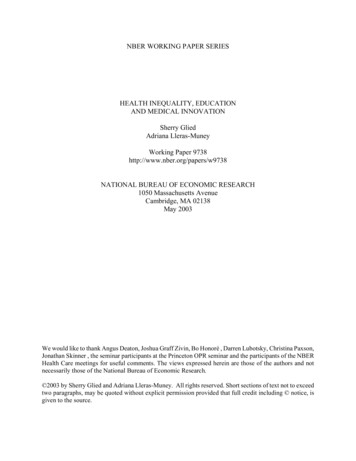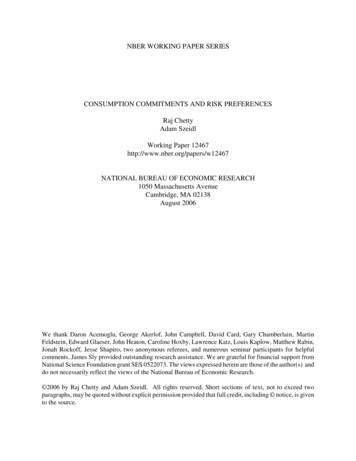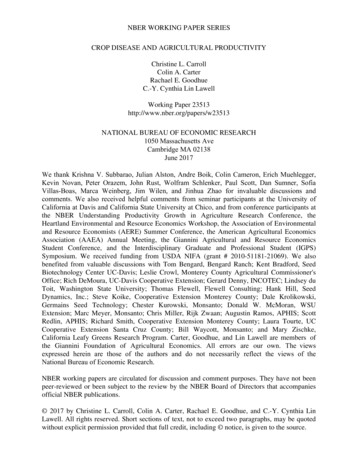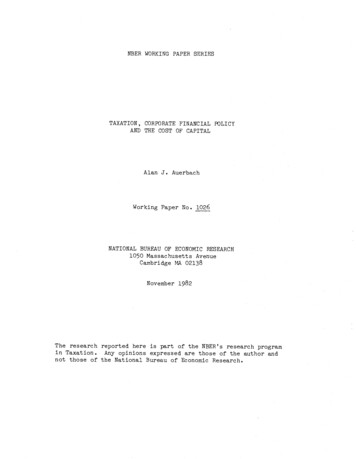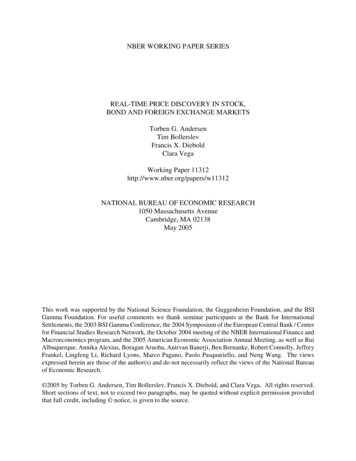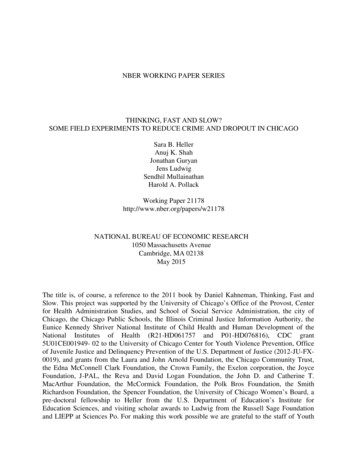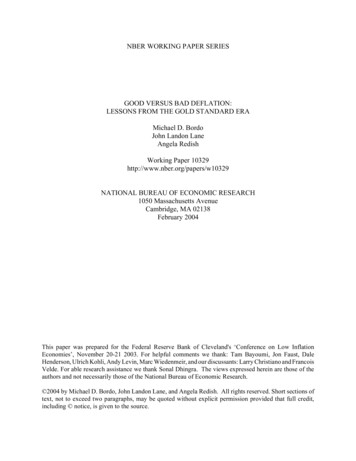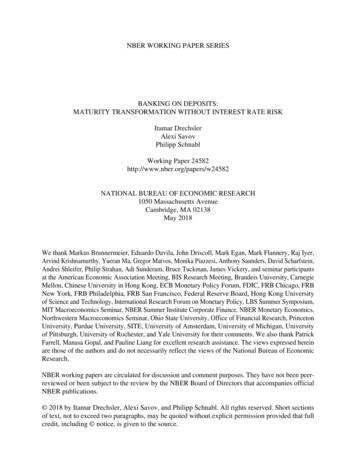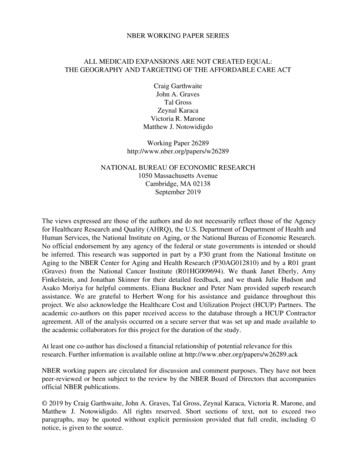
Transcription
NBER WORKING PAPER SERIESALL MEDICAID EXPANSIONS ARE NOT CREATED EQUAL:THE GEOGRAPHY AND TARGETING OF THE AFFORDABLE CARE ACTCraig GarthwaiteJohn A. GravesTal GrossZeynal KaracaVictoria R. MaroneMatthew J. NotowidigdoWorking Paper 26289http://www.nber.org/papers/w26289NATIONAL BUREAU OF ECONOMIC RESEARCH1050 Massachusetts AvenueCambridge, MA 02138September 2019The views expressed are those of the authors and do not necessarily reflect those of the Agencyfor Healthcare Research and Quality (AHRQ), the U.S. Department of Department of Health andHuman Services, the National Institute on Aging, or the National Bureau of Economic Research.No official endorsement by any agency of the federal or state governments is intended or shouldbe inferred. This research was supported in part by a P30 grant from the National Institute onAging to the NBER Center for Aging and Health Research (P30AG012810) and by a R01 grant(Graves) from the National Cancer Institute (R01HG009694). We thank Janet Eberly, AmyFinkelstein, and Jonathan Skinner for their detailed feedback, and we thank Julie Hudson andAsako Moriya for helpful comments. Eliana Buckner and Peter Nam provided superb researchassistance. We are grateful to Herbert Wong for his assistance and guidance throughout thisproject. We also acknowledge the Healthcare Cost and Utilization Project (HCUP) Partners. Theacademic co-authors on this paper received access to the database through a HCUP Contractoragreement. All of the analysis occurred on a secure server that was set up and made available tothe academic collaborators for this project for the duration of the study.At least one co-author has disclosed a financial relationship of potential relevance for thisresearch. Further information is available online at http://www.nber.org/papers/w26289.ackNBER working papers are circulated for discussion and comment purposes. They have not beenpeer-reviewed or been subject to the review by the NBER Board of Directors that accompaniesofficial NBER publications. 2019 by Craig Garthwaite, John A. Graves, Tal Gross, Zeynal Karaca, Victoria R. Marone, andMatthew J. Notowidigdo. All rights reserved. Short sections of text, not to exceed twoparagraphs, may be quoted without explicit permission provided that full credit, including notice, is given to the source.
All Medicaid Expansions Are Not Created Equal: The Geography and Targeting of theAffordable Care ActCraig Garthwaite, John A. Graves, Tal Gross, Zeynal Karaca, Victoria R. Marone, and MatthewJ. NotowidigdoNBER Working Paper No. 26289September 2019JEL No. H51,H75,I13ABSTRACTWe use comprehensive patient-level discharge data to study the effect of Medicaid on the use ofhospital services. Our analysis relies on cross-state variation in the Affordable Care Act’sMedicaid expansion, along with within-state variation across ZIP Codes in exposure to theexpansion. We find that the Medicaid expansion increased Medicaid visits and decreaseduninsured visits. The net effect is positive for all visits, suggesting that those who gain coveragethrough Medicaid consume more hospital services than they would if they remained uninsured.The increase in emergency department visits is largely accounted for by “deferrable” medicalconditions. Those who gained coverage under the Medicaid expansion appear to be those whohad relatively high need for hospital services, suggesting that the expansion was well targeted.Lastly, we find significant heterogeneity across Medicaid-expansion states in the effects of theexpansion, with some states experiencing a large increase in total utilization and other statesexperiencing little change. Increases in hospital utilization were larger in Medicaid-expansionstates that had more residents gaining coverage and lower pre-expansion levels of hospitaluncompensated care costs.Craig GarthwaiteDepartment of StrategyKellogg School of ManagementNorthwestern University2001 Sheridan RoadEvanston, IL 60208and NBERc-garthwaite@kellogg.northwestern.eduJohn A. GravesVanderbilt University2525 West End Ave.Suite 1200Nashville, TN 37203john.graves@vanderbilt.eduTal GrossQuestrom School of Business595 Commonwealth Ave.Boston, MA 02215and NBERtalgross@bu.eduZeynal KaracaAgency for Healthcare Research and Quality5600 Fishers LaneRockville, MD 20857USAZeynal.Karaca@ahrq.hhs.govVictoria R. MaroneNorthwestern UniversityEvanston, IL 60208marone@u.northwestern.eduMatthew J. NotowidigdoNorthwestern UniversityDepartment of Economics2001 Sheridan RoadEvanston, IL 60208-2600and NBERnoto@northwestern.edu
The United States healthcare sector is often described as a market-based system driven by private firms. The government, nevertheless, plays an enormous role. As of 2018, over half of allU.S. healthcare expenditures came from the public sector—primarily through Medicare andMedicaid, but also through the subsidization of employer-sponsored health insurance via thetax code. Medicare has covered the elderly (65 and over) population in the U.S. since its creationin 1965, and growth in program enrollment has been driven primarily by shifting demographics.Medicaid, by contrast, has grown from a program that initially targeted the indigent and thedisabled to a far more generous program that currently provides coverage to over 70 millionAmericans (Rudowitz, Antonisse, and Hinton 2018).Expansion of Medicaid eligibility can be thought of as a reflection of society’s evolvingbeliefs about social insurance. Historically, Medicaid enrollees needed to be both low-incomeand in a particular category in order to qualify for coverage. Coverage was extended to pregnantwomen and their children in the 1980s and then to relatively higher-income children in the1990s through the State Children’s Health Insurance Program. Throughout the 1990s and2000s, states used federal waivers to expand Medicaid to additional categories of low-incomeindividuals. These expansions mostly covered parents but, in only a few states, covered lowincome childless adults (Long, Zuckerman, and Graves 2006). This focus on categorical eligibility was partly motivated by a belief that individuals in these specific groups were in particularneed of assistance and that limiting the eligibility criteria to include only those groups couldincrease the target efficiency of Medicaid spending.The largest and most-controversial expansion occurred with the implementation of theAffordable Care Act (ACA) in 2014. For those earning below 138 percent of the federal povertyline (approximately 16,600 for an individual in 2019), the ACA fundamentally changed theconcept of Medicaid eligibility. It did so by stripping away categorical requirements, along withconsiderations over non-income assets, for the purposes of determining program eligibility forthe under-age-65 population. Instead, the law transformed Medicaid into an entitlement withnew eligibility criteria based on a current monthly modified adjusted gross income (MAGI)standard.1Categorical eligibility determinations are still used within non-expansion states and within the entire the Medicaidprogram to determine the share of state vs. federal financing. Moreover, asset tests can still be used for eligibilitydeterminations of individuals over age 65.11
Expansion of Medicaid eligibility to a greater fraction of the low-income population wasdriven by a variety of motivations. Certainly, policymakers were motivated by the desire to ensure some baseline level of access to healthcare. As such, the expansions reflected the preferences of the electorate over what this baseline level of access entails.2 That said, policymakerswere also motivated by questions regarding the efficiency of the healthcare sector. Specifically,policymakers and advocates for the ACA routinely noted that lack of access to formal insuranceresults in healthcare being provided in more-expensive settings than would otherwise be necessary (e.g., primary care services provided in emergency departments).Finally, federal lawmakers have also shown a preference for establishing a baseline ofaccess to healthcare across states. While Medicaid has always been a state-administered program,federal expansions have progressively raised the floor of who would be covered in all states.States have always had—and many have exercised—the right to exceed that floor and providemore-generous social insurance. In this way, federal Medicaid policy serves as a safety net thatreflects the nation’s preferences for a compromise, maintaining a minimum level of access butallowing for variation above that minimum across states.The ACA represents the largest reform of the healthcare sector since the creation of the“Great Society” programs in the 1960s. But after nearly a decade since the ACA’s adoption,approximately 10 percent of the non-elderly population remains formally uninsured. This persistence of uninsurance stems, in part, from a 2012 Supreme Court decision that allowed statesto refrain from implementing the ACA’s Medicaid expansion. In 2014, the expansion was fullyimplemented with 100-percent federal financing, and only 24 states elected to expand Medicaid.Over the next three years, an additional 7 states adopted expansions. Currently, 36 states haveexpanded their Medicaid programs under the (nearly full) federal financing and authority grantedby the ACA. Research has shown that state expansion decisions have meaningful impact onaccess to formal insurance. As of 2018, the share of the population without insurance was 16.1percent in non-expansion states compared to 7.5 percent in expansion states (Haley et al. 2018).While the decision over whether to expand Medicaid is clearly an important one, a variety of other policy decisions have contributed to an ongoing lack of universal coverage in theIn 2013, President Obama defended that ACA and cited both its social-insurance benefits and increased accessto healthcare: “In the wealthiest nation on Earth, no one should go broke just because they get sick. In the UnitedStates, health care is not a privilege for the fortunate few, it is a right” (Wilson and Wiggins 2013).22
U.S. These include features of the ACA as well as differences in implementation decisions bothwithin and across states. Lack of universal coverage has led to a variety of calls to further expandthe social safety net for healthcare. These policies range from expansions of the existing ACAframework to a single-payer system that covers the entire nation.Evaluating the efficacy of an expanded social insurance system requires careful consideration of the impact of previous expansions. In this paper, we examine the effects of the ACAusing a large dataset maintained by the Agency for Healthcare Research and Quality (AHRQ)that covers the near universe of hospitalizations in 20 states. In each of those states, shown inFigure 1, we have data from 2012 to 2015 covering all outpatient and inpatient emergency department (ED) visits as well as inpatient hospitalizations that initiated in the ED.3 As we consider the ACA, three natural questions arise that can inform both the design of future expansionefforts as well as help understand broader economic effects of existing social insurance programs.First, did the ACA’s expansion of Medicaid lead to a more-efficient utilization ofhealthcare? In particular, did those who became newly insured through Medicaid decrease theiruse of the ED? To answer this question, we use several identification strategies to examineoverall and state-level impacts of the Medicaid expansion on ED use. We find consistent evidence across those identification strategies that Medicaid coverage increased the use of hospitalservices. The estimates rule out large declines in the use of the ED as a result of Medicaidexpansions.Second, did the expansion and transformation of Medicaid meet the goal of providingaccess to healthcare for those who most needed it? This is often described as the “target efficiency” of social insurance: the degree to which those who gain coverage are those who mostneed the assistance. To examine the target efficiency of the ACA we examine the use ofhealthcare for the newly insured compared to those who remain ineligible for the expandedprogram. We find that those gaining access to Medicaid in expansion states had greater preexpansion utilization of healthcare than those who remained uninsured. This suggests that theThe data encompass about 95 percent of all discharges in each state. HCUP databases do not include Federalhospitals (e.g., Veterans Affairs, Department of Defense, and Indian Health Service hospitals), long-term hospitals,psychiatric hospitals, alcohol/chemical dependency treatment facilities, and hospital units within institutions suchas prisons.33
expansion of Medicaid based on income, rather than specific categories of need, successfullytargeted the remaining uninsured with greater pre-expansion use of medical services. Lookingat non-expansion states, we see an increase in private insurance driven by the creation of theACA marketplaces. In this setting, we find that those who purchased private insurance werealso those with the greatest use of medical services. This suggests that the subsidized marketplaces, even though they required contributions from enrollees, provided coverage to those witha greater demand for healthcare services.Finally, we examine heterogeneity in the impact of the expansion across states. At aminimum, the decision of some states to not expand Medicaid created variation in the socialsafety net across states. We investigate other sources of heterogeneity in the effects of the ACAacross states. This variation extends beyond simply the question of take-up (i.e. how much ofthe eligible population signed up for formal insurance) and also reflects differences in the increase in the use of hospitals services among the newly insured. This heterogeneity should generate some caution in generalizing results from previous state expansions to other settings. Italso provides some explanation for the heterogeneity in the existing literature on the relationshipbetween Medicaid coverage and hospitalizations. Across all the states in our sample, we findthat the ACA Medicaid expansion resulted in an increase in the use of hospital services. In anumber of states, however, the estimated effect is small and statistically indistinguishable fromzero. We also examine heterogeneity in the target efficiency of the expansions, finding that thedegree to which the expansions could target those with the greatest need for medical servicesvaried meaningfully across states.1. Medicaid Expansions and the Use of Hospital ServicesConcerns about access to healthcare have resulted in regulations that make the sale ofhealthcare fundamentally different from other sectors of the economy. For instance, hospitalEDs are required by law to stabilize anyone with an emergency condition regardless of theirability to pay.4 This creates several economic frictions. First, hospitals are effectively required toserve as “insurers of last resort” for care not paid for directly by patients or explicitly financed4The Emergency Medical Treatment and Active Labor Act (EMTALA) introduced this requirement in 1983.4
via public or private insurance (Garthwaite, Gross, and Notowidigdo 2018).5 Second, since onlyhospitals with EDs are covered by this mandate, some conditions may be treated in the relativelyhigh-marginal-cost setting of the hospital ED when they could be more efficiently treated inother, lower-cost settings. Third, the uninsured are often unable to gain access to routine, preventive primary care and expensive pharmaceuticals. Thus, there is a concern that medical conditions that could have been managed early and at a lower cost instead develop into acute episodes that end up costing the entire system more than they otherwise would if there were morewidespread insurance coverage.Differences in the ability to access healthcare can be seen in the data. Table 1 describesthe use of hospital services by insurance status before the ACA. In our data, only 2.2 percent ofthe hospital visits for the uninsured were inpatient stays that did not originate in the ED. Thisis far less than the share for Medicaid patients (10 percent) and the privately insured (14.1 percent). Relatedly, three-quarters of the inpatient visits for the uninsured began in the ED. Thecorresponding numbers for Medicaid recipients and the privately insured are much lower, approximately 52 and 41 percent, respectively. Overall, those with private insurance had the lowestuse of hospital services, which likely reflects the fact that those with private coverage are relatively healthy.6These estimates suggest that while the uninsured do have access to healthcare throughthe ED, there are legitimate concerns that they lack access to more-discretionary and expensivehealthcare services. Those concerns are often called the “access motive” for health insurance.The access motive argues that consumers need health insurance for reasons that extend beyondthe need to smooth consumption across different states of the world, that is, the traditionaleconomic rationale for insurance. Rather, an additional primary benefit of health insurance is tomaintain access to healthcare for liquidity constrained populations (Nyman 1998; Besanko,Dranove, and Garthwaite 2016).The access motive was cited by many policymakers in support of the ACA. For example,Speaker of the House Nancy Pelosi argued that “the uninsured will get coverage, no longer leftWhile hospitals do receive supplementary funding to account for these expenses, the degree to which these fullyreinsure hospitals is unclear. For example, Garthwaite, Gross and Notowidigdo (2018) find that hospital bear thebrunt of the costs of marginal uninsured patients through lower profits.6 Despite some erroneous commentary in the popular press, it is wrong to consider this higher use of medicalservices by Medicaid recipients as a causal effect of Medicaid decreasing people’s health.55
to the emergency room for medical care” (Blase 2016). On the opposite side of the aisle, RickSnyder, the Republican Governor of Michigan argued: “uninsured citizens often turn to emergency rooms leading to crowded emergency rooms, longer wait times and higher costs. Byexpanding Medicaid, those without insurance will have access to primary care, lowering costsand improving overall health” (Kliff 2014).As is often the case, economic research on this topic is less clear than what one wouldinfer from the statements of activists and policymakers. It is true that the uninsured often facebarriers to care outside of the ED. That said, care at the ED for the uninsured can be quitecostly to the uninsured themselves. While hospitals are required to stabilize emergency patientsregardless of their ability to pay, they are allowed to (and often do) bill for these services. Existing evidence suggests that hospitals do not recover all—or even most—of the costs of providingthis service, but they do enact meaningful financial and psychic costs on those from whom theyattempt to collect (Mahoney 2015). Non-profit hospitals enjoy tax-exempt status because theyprovide “community benefit,” including charity care to the uninsured. But even these non-profithospitals have been shown to go to great lengths—including litigation and wage garnishment—to re-cover unpaid bills.7As a result, health insurance decreases the cost of accessing the ED, and this couldcreate a moral-hazard response that results in more ED visits. That moral-hazard effect couldbe exacerbated by both perceived and real transaction costs. These costs derive from the needto separately secure office-based appointments, lab tests, and other complementary servicesoutside of the emergency setting. This requires identifying a set of providers that accept Medicaid as a form of payment and have availability for appointments—a process that can be timeconsuming. By comparison, nearly all hospital-based EDs accept Medicaid as payment, offer awide spectrum of services under one roof, and have minimal differential cost-sharing requirements for Medicaid patients. In addition, it is unclear whether ED services are a complementor a substitute for primary care, or whether that relationship might vary itself by insurance status.For example, a recent investigation by ProPublica found that Methodist Le Bonheur Healthcare in Memphisbrought thousands of lawsuits for unpaid medical bills in recent years (Thomas 2019), and the New York Timespublished a similar investigation into the collection efforts of nonprofit hospitals back in 2004 (Cohn 2004). Suchpractices have led some politicians to discuss trying to “rein in” nonprofit hospitals that bring lawsuits and garnishwages (Armour 2019).76
Numerous studies have found clear evidence that Medicaid coverage tends to increasehealthcare consumption in general and ED visits in particular. The Oregon Health InsuranceExperiment found that low-income, uninsured people who gain health insurance coveragethrough Medicaid are 40 percent more likely to visit an emergency department (Taubman et al.2014). That finding matches the conclusions of work by Nikpay et al., (2017); Anderson et al.,(2012); Anderson et al., (2013); Card et al., (2008); Dresden et al., (2017); DeLeire et al., (2017);Garthwaite et al. (2017); Smulowitz et al., (2014); and Heavrin et al., (2011).These studies have shown that insurance coverage increases the likelihood of an EDvisit. But the literature is not entirely uniform on this point. Antwi et al. (2015), HernandezBoussard et al. (2014), and Sommers et al. (2016) all conclude that expansions of Medicaidactually decrease the risk of an ED visit. In particular, Miller (2012) finds that the Massachusettshealth care reform—which nearly eliminated the uninsured population in that state—decreasedED visits overall.Some of the disagreement across these studies may be driven by general-equilibriumeffects in the provision of medical services. For example, in a more heavily insured population,primary-care physicians or other outpatient facilities may change their business practices to accommodate the new payer mix in ways that change the use of ED facilities (Richards, Nikpay,and Graves 2016). This could explain why two of the studies of the market-wide change inMassachusetts produced estimates that were different from the general thrust of the literature.By changing both the quantity and setting of healthcare consumed, expansions of Medicaid can have meaningful economy-wide impacts. To the extent that expansion leads to lowerhealthcare spending, this can free up economic resources for more-efficient uses in other partsof the economy. In addition, to the extent that more-efficient provision of healthcare can increase the underlying health of the population, it could also increase labor-force productivityfor those affected. Both of these channels suggest meaningful macroeconomic impacts fromchanges to Medicaid.Determining the broader economic impact of Medicaid is even more important giventhe current uneven geographic access to the ACA Medicaid expansion. As of mid-2019, 13states have still not expanded their programs. In the next section, we describe the specifics ofthe ACA Medicaid expansion, which underlies our various identification strategies.7
2. Background on the ACA Medicaid ExpansionOf primary importance to the questions in this paper, the ACA increased access tohealth insurance through both a large expansion of Medicaid for low-income populations aswell as the creation of a series of state-based insurance marketplaces where individuals couldpurchase non-group insurance. Those purchasing insurance in these individual marketplacescould not be denied coverage for pre-existing medical conditions and their premiums could onlyvary by smoking status, across geographic rating areas determined by the state, and by age (withthe ratio of premiums across age groups not to exceed 3-to-1). In order to combat adverseselection, individuals were mandated to purchase insurance or pay a penalty on their incometaxes.8Legal residents who earn less than 138 percent of the FPL are eligible for Medicaid.Those who earn between 100 and 400 percent of the FPL and who aren’t otherwise Medicaideligible qualify for federal subsidies that limit marketplace plan premiums to a fixed percentageof the enrollee’s income. Those earning between 138 and 250 percent of the FPL receive additional subsidies that limit their exposure to cost sharing (e.g., deductibles, co-payments and coinsurance). Those who earn more than 400 percent of the FPL, and those under 100 percent ofthe FPL, can still purchase insurance on the marketplace but they are required to pay the entirepremium.The ACA was exceptionally controversial and attracted large amounts of litigation. Inthe summer of 2012, the US Supreme Court upheld the constitutionality of the ACA’s individualmandate. However, the Court also allowed states to opt out of the act’s expansion of Medicaidto 138 percent of the FPL.For those living in states that did not expand Medicaid, access to formal health insuranceeffectively depends on family income. Those who earn between 100 and 138 percent of thefederal poverty level can purchase heavily subsidized insurance on the marketplace. These individuals also receive generous cost-sharing subsidies that made their coverage more similar toMedicaid—though Medicaid could be a preferred coverage vehicle given its even-lower cost-The individual mandate was effectively eliminated as part of a Congressional reform of the federal tax system in2017.88
sharing requirements, zero-dollar premiums (in some states), and a broader range of benefitsthan traditionally covered by private plans (e.g., transportation services).Residents in non-expansion states that earn less than 100 percent of the federal povertyline (FPL) fall into a “coverage gap.” These residents earn too much money to quality for theirstate’s relatively parsimonious and categorically based Medicaid program and too little to qualifyfor subsidies on the ACA marketplaces. According to the Kaiser Family Foundation, this hasresulted in approximately 2.5 million residents that lack access to health insurance based solelyon their state of residence. Nearly half of these residents live in either Florida or Texas and over90 percent live in the southern US. Given the state-based nature of decisions about the ACA,the potential economic benefits of the increased social insurance and the economic opportunities that it might provide can impact the economic growth of different geographies. In addition,the uneven implementation of Medicaid expansion under the ACA raises concerns over equity.To a greater degree than in the past, Americans’ access to healthcare often depends on the statein which they reside.The number of people in the coverage gap meant that the share of the uninsured population fell faster in expansion states compared to non-expansion states. For example, in thefirst quarter of 2018, the share uninsured in non-expansion states was 16.1 percent comparedto 7.5 percent in expansion states (Haley et al. 2018). In addition to having a higher share uninsured, the composition of the insured market also differed based on a state’s Medicaid expansion decision. In expansion states, those between 100 and 138 percent of poverty enrolled inMedicaid. However, in non-expansion states these individuals had access to heavily subsidizedinsurance through the marketplaces. Thus, one would expect the share with private insuranceto be different across these states after the implementation of the ACA.3. DataThe primary databases used in our empirical analysis are the State Emergency DepartmentDatabase (SEDD) and the State Inpatient Database (SID). The databases are part of theHealthcare Cost and Utilization Project (HCUP) and are maintained by the Agency forHealthcare Research and Quality (AHRQ).9
The SID and the SEDD are both made up of state-specific files. Each state-specific filecovers a near-census of hospital and ED visits for a given calendar year. The databases aredetailed and comprehensive; they are well-suited to studying state-level policy changes. Ouranalysis focuses on the following 20 states: Arizona, California, Connecticut, Florida, Georgia,Iowa, Indiana, Kansas, Maryland, Minnesota, Missouri, New Jersey, New York, Ohio, RhodeIsland, South Carolina, South Dakota, Utah, Vermont, Wisconsin.9 These states cover 51 percent of the U.S. population and 55 percent of the Medicaid population, and include both expansion and non-expansion states.10The SID contains about 97 percent of all inpatient hospitalizations in participating states,while the SEDD contains more than 95 percent of ED encounters. Both databases contain aset of clinical information (e.g., length of stay, primary and secondary diagnoses) and nonclinicalinformation (e.g., age, gender, race, total charges) on all patients, including individuals coveredby Medicare, Medicaid, or private insurance, as well as those who are uninsured.11 In this paper,we focus on the primary diagnosis code, since it allows us to categorize hospitalizations into“deferrable” or “non-deferrable” visits.We follow Mulcachy et al. (2013) and Garthwaite et al. (2017) in identifying deferrable andnon-deferrable visits. Deferrable visits are those for which a panel of physicians indicates thatthe patient likely has some discretion as to when to present to a professional. By contrast, nondeferrable visits are hospital visits for one of 12 conditions that have been identified by a panelof physicians as likely to require immediate medical treatment regardless of insurance coverageor financing. For instance, an intracerebral hemorrhage is classified as non-deferrable visit—patients with this condition would almost certainly present at an ED regardless of their insurance status.12We selected this sample of s
Aging to the NBER Center for Aging and Health Research (P30AG012810) and by a R01 grant (Graves) from the National Cancer Institute (R01HG009694). We thank Janet Eberly, Amy Finkelstein, and Jonathan Skinner for their detailed feedback, and we thank Julie Hudson and . Evanston, IL 60208 and NBER c-garthwaite@kellogg.northwestern.edu John A .
